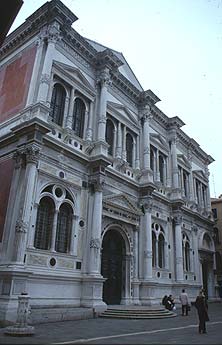 The term "scuola" refers to the architectural context in which it was gathered, but also to the group of individuals who gathered to safeguard the interests of a particular work from which the name of Schools of art and crafts, or even in the case of learning of Christian virtues, there were Schools of Devotion or Confraternities,
finally, there were the Schools of nationalities that brought together different foreign communities in the city, such as the Schiavoni School.
Each school had its own regulation (capitulare or mariegola), with precise tasks for the leaders as well as for the subjects. The term "scuola" refers to the architectural context in which it was gathered, but also to the group of individuals who gathered to safeguard the interests of a particular work from which the name of Schools of art and crafts, or even in the case of learning of Christian virtues, there were Schools of Devotion or Confraternities,
finally, there were the Schools of nationalities that brought together different foreign communities in the city, such as the Schiavoni School.
Each school had its own regulation (capitulare or mariegola), with precise tasks for the leaders as well as for the subjects.
The members of the schools were often members of the bourgeois class, so non-patrician citizens and therefore excluded from the oligarchic government of the Republic. In turn the nobles could be confreres but did not hold government positions.
If at the beginning these Scuole were totally autonomous from the State, they were soon subjected to a specific Magistracy which defined the term of office of the leaders and which, at times, also oversaw the drafting of the same Capitulars.
Every school, however, always referred to a parish or convent church: if the confreres were wealthy and numerous, then the school could afford its own building, used for social gatherings. In these cases, the schools were often enriched with real estate and furniture, so as to be transformed into large economic complexes with banking functions also against the State (an emblematic example is represented by the School of St. Rocco which in 1661 had the highest income year between the Venetian private bodies).
The Scuole of devotion are subdivided into smaller and smaller schools.
According to Sansovino, the first, so called for the splendor of their buildings and their internal treasures, were reduced to only six in total: Santa Maria della Carit� (1260), San Giovanni Evangelista (1261), Santa Maria in Valverde, later called della Misericordia (1261), San Marco (1260), San Rocco (1478), San Teodoro (1250) and, lastly, San Maria del Carmelo, called dei Carmini (1767).
Any form and type of Scuola unfortunately ended all its activities with the end of the Republic and their definitive closure took place with the Napoleonic suppression in 1806.
Fortunately, that of S. Rocco was saved, while those of S. Giovanni, della Misericordia and dei Carmini were rebuilt in the 19th century.
Only recently (1960) reborn that one of S. Teodoro. The fate for the Scuole Minori was different, and none of them was saved. |
 The term "scuola" refers to the architectural context in which it was gathered, but also to the group of individuals who gathered to safeguard the interests of a particular work from which the name of Schools of art and crafts, or even in the case of learning of Christian virtues, there were Schools of Devotion or Confraternities,
finally, there were the Schools of nationalities that brought together different foreign communities in the city, such as the Schiavoni School.
Each school had its own regulation (capitulare or mariegola), with precise tasks for the leaders as well as for the subjects.
The term "scuola" refers to the architectural context in which it was gathered, but also to the group of individuals who gathered to safeguard the interests of a particular work from which the name of Schools of art and crafts, or even in the case of learning of Christian virtues, there were Schools of Devotion or Confraternities,
finally, there were the Schools of nationalities that brought together different foreign communities in the city, such as the Schiavoni School.
Each school had its own regulation (capitulare or mariegola), with precise tasks for the leaders as well as for the subjects.